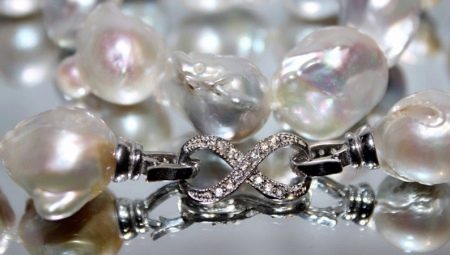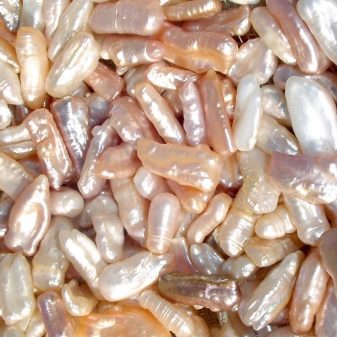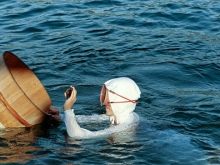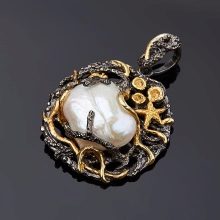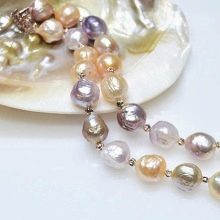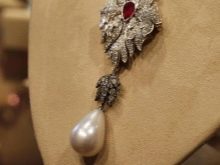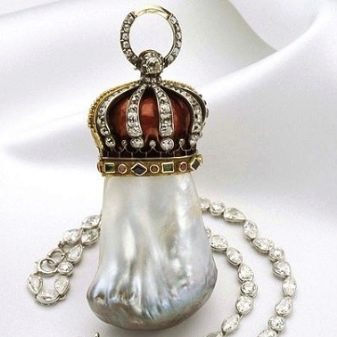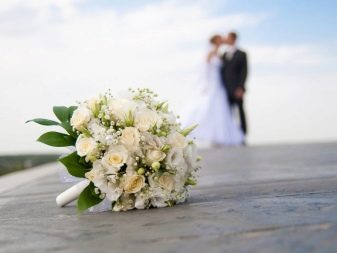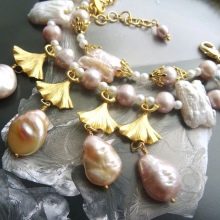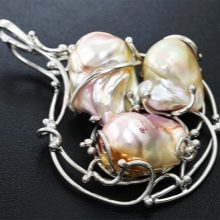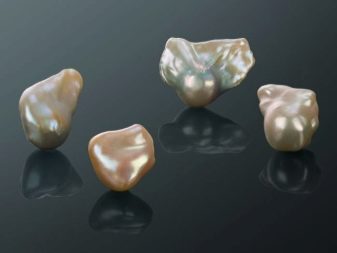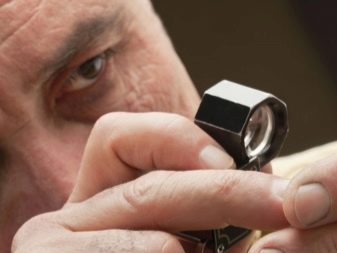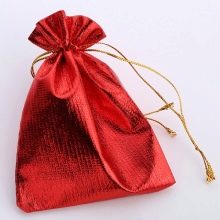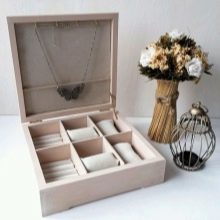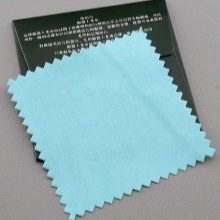Few people know that a perfectly round pearl is rather an exception to the rule. Fancy, irregular shapes are more characteristic of natural pearls, which are called baroque, from the word baroque. In more detail about this pearl, about its properties and types, about care of it we will tell in our article.
What it is?
Pearl lovers and connoisseurs know that, in addition to spherical beads, natural mother-of-pearl can take various forms - drop-shaped, asymmetrical, oval, with various irregularities, pear-shaped, ellipse-shaped and others. Exactly such The pearls of the original, fanciful forms are called baroque.. The name is derived from the style in art - Baroque, literally translated from Italian, as "strange", "quaint", "having a tendency to excess". However, the translation of the word “baroque” from Portuguese, which means “unpolished”, “not processed”, is more appropriate for this type of pearl.
By type of origin Baroque pearls are:
- natural marine;
- natural river, freshwater;
- natural, cultivated on a special farm;
- artificial.
The formation of naturally pearls is a natural unique process in which a speck or grain of sand gets into the shell of a mollusk. Trying to get rid of a foreign object, the clam covers it with pearl layers, and in 12 months it grows a pearl of only 2-2.5 millimeters. It is noticed that the growth rate depends on the age of the oyster - in the shell of a young mollusk the process of pearl growth occurs faster than in old ones. But also for the growth rate, sea water is more favorable than fresh water. Most often, baroque pearls are found in warm, southern seas.
The correct form of a rounded pearl suggests that its formation occurred in the central part of the shell. Baroque pearls are formed at the shell walls, in contact with the mollusk itself. The size of a natural baroque nacre is usually small, but there may be large specimens, which are appreciated by jewelers and can cost more than perfectly spherical pearls. Literate jewelers see flowers, petals, animal and bird figures in the silhouettes of baroque pearls, their imagination is limitless and helps to create unique creations from them.
The color range of baroque mother of pearl is wide and varied. These are all milky shades, white and light beige tones, pearls the color of coffee with milk, pink, yellow, blue, golden, grayish blue and even black.
Due to its unusual form, baroque pearls have a special brilliance of nacre and fascinating play of its shades.
Facts from the story
Gems and historical figures are inextricably linked with each other, expensive jewelry emphasizes the status of its owner. Among the famous jewelery of the powerful, several jewels made of baroque pearls are known. They are given their own names and, in the end, the stones and pearls themselves become more famous than their owners. Thus, the legend of the love of the Roman politician Mark Antony and Egyptian Queen Cleopatra says that as proof of her feelings she removed her precious earrings from baroque pearls in the form of a pear and dissolved them in wine that the Roman drank. Later, according to legend, these pearls shone on the statue of Venus, decorating the goddess of love.
A large drop-shaped pearl of the baroque "Peregrina", found off the Panamanian coast in the middle of the 16th century, first gave freedom to her slave who found her. Then she was presented to Philip the Second, the autocrat of Spain, who presented “Peregrine” to the most august English woman, Maria Tudor, as a wedding presentation. No wonder “Peregrina” in translation means “pilgrim”, because after that the pearl visited Bonaparte, was captured in the portrait of the Spanish queen, and the French marquis also owned it, buying it from Napoleon III, who needed money. Marquis' wife suffered distraction, which was the creation of a necklace from a pearl.
In the 20th century (1969), a necklace with “Peregrina” is exhibited at a British auction, at which the husband acquires it for his wife, Queen of Hollywood - E. Taylor. She wore jewelry as a brooch and one day her dog almost ate a pearl. After that, the decoration with the "pilgrim" turned into a decoration of Cartier. After the death of the great actress, a jewel with a pearl was auctioned for almost 12 million dollars.
Another rare baroque egg-shaped pearl named Regent, weighing about 80 carats, belonged to Napoleon Bonaparte. Having bought it for a huge amount, Napoleon presented it to his wife, and until 1887 she was in their possession. Then I bought the famous Faberge pearl and brought the jewel to Russia. However, the financial difficulties of the young Soviet country prevented the pearl from staying with us, and together with other jewelery it falls to the West. The largest today is the baroque pearl of Hope (named for the name of its owner), its diameter is 5.1 cm, and the shape is pear-shaped. Now every visitor to the London Museum of Natural History can admire it.
Properties
Being a mineral of natural origin, pearls are fraught with many healing and mystical properties. The purpose of wearing pearls is exclusively female; men almost do not wear mother-of-pearl.
Emphasizing the beauty of its owner, the baroque pearls also strengthens her health.
Medicinal
Baroque pearls have a positive effect on the nervous system of its owner. His psycho-emotional state is stabilizing, fears and doubts disappear. Many people believe that pearls are able to protect their host from nervous disorders.
The mind and memory of those wearing baroque mother of pearl are becoming lighter. Specialists in healing stones claim that pearls are able to cure sclerosis and improve the functioning of internal organs, especially the kidneys and liver. It is recommended to wear jewelry made of baroque pearls for those who have problems with both high and low blood pressure. While wearing socks, you should pay close attention to pearls - darkened pearls appear from the negative mood or diseases of its owner.
Magical
Maiden beauty and chastity are associated with pearls, including baroque ones, they often decorated the bride on their wedding day. But in each country their special properties are attributed to pearls. In India, they are worn to attract wealth, in China, pearls give kindness and mercy to the owner, with the help of the Greeks guarding the family hearth. It is believed that the sparkling nacre eliminates loneliness, protects the house from thieves, gives good luck to businessmen.
Since nacre is formed in the water element, it is recommended to wear it to representatives of this group of zodiac signs. This mineral is more suitable for people with a strong character, pearls bring absent-mindedness to a person with a weak, unstable nature.
It is highly undesirable to wear a single jewelry with pearls, for earrings it is better to add a pearl necklace in a pair. Otherwise, there is a threat to be alone.
Jewelry products
It is considered that baroque pearls are ideal material for beginner jewelers who only acquire the skills of fine craftsmanship.This is partly true, but if a good master sees a large baroque pearl of successful form, he will definitely embody his artistic idea in it. A jewel with such a unique pearl will definitely become exclusive, because there are no two baroque pearls of the same shape and color in nature.
Usually, baroque pearls in jewelry are complemented with other precious stones and metals, and they are complemented with jewelry from traditional round pearls. Elongated, in the form of a drop or pear, baroque pearls are in demand for the creation of pendants, earrings, brooches. It is customary to make rings, pendants, brooches, tiaras or necklaces from pearls resembling the silhouettes of plants, animals, birds or profiles of faces.
Refined bracelets, necklaces, necklaces or earrings are collected from small pearls of irregular shape. A woman of any age can wear pearl jewelry - in a young, mature and elegant.
How to distinguish a fake?
The high popularity of baroque pearl products stimulates dishonest producers to create artificial imitation. You should carefully consider the decoration in detail and from all sides, not yielding to the entreaties of the seller about his naturalness. It is possible to distinguish fake baroque pearls from natural ones by some nuances.
- The seam or line of gluing on the bead. Often the irregular shape is achieved by careless sellers by gluing together several pieces of nacre.
- Coating layer Pearl can be simulated with special paints. However, artificial paint looks dull, dark and without gloss compared to natural mother of pearl.
- The surface of each pearl should be rough, uneven. And also some people test the naturalness of pearls "on the tooth" - they are quite soft and leave dents.
- Placer on the glass. A handful of pearls are scattered on a glass surface, artificial peas will roll, and natural peas will jump slightly.
- Show an experienced independent jeweler who will certainly determine the authenticity of the pearl.
How to care?
Like any jewelry, baroque pearls require careful and careful care. In this case, he will long please his owner with a beautiful appearance. Here are some guidelines for caring for baroque pearls.
- Do not apply perfume, toilet water directly on the pearl jewelry. After a pause of 12-15 minutes after applying a cosmetic, perfume or deodorant on the skin, you can wear pearls.
- Do not allow natural mother-of-pearl to come into contact with various chemicals.
- Protect from direct sunlight and overheating. In the summer, pearls should be worn only in the evening.
- Store in a casket upholstered in soft natural fabric or in a pouch, separate from hard gems and jewelry that have sharp edges.
- Clean occasionally with a soft, natural cloth.
- Do not wear it in too wet and hot rooms - a pool or sauna.
Human skin has an ideal PH level for pearls, so you should wear it on your body as often as possible, following all precautions. Then the pearl jewelry will become the object of admiration of others and will be passed on to more than one future generation.
How to distinguish artificial pearls from natural, see the following video.
